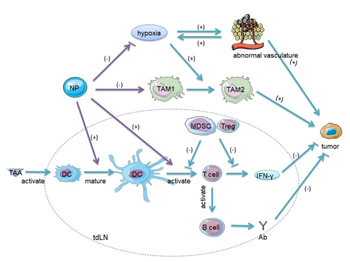Why nanoparticles could prove a game changer for cancer immunotherapy
Published 13 August, 2021
The major goal of cancer therapy is to destroy cancer cells while sparing the surrounding, healthy tissue. The term ‘tumour microenvironment’ (TME) describes the area around a tumour, which typically consists of blood vessels and immune cells etc. As the TME can impact tumour progression and metastasis, finding a way to control it is high on the wishlist of researchers. For many, nanoparticles – particles of matter that generally vary between 1 and 100 nanometres in size – offer a promising solution. Alongside their prolonged retention time and ability to directly attack cancer cells, with delicate modification, these nanoparticles could achieve targeted delivery and effective control of the TME.
In a study, published in the KeAi journal Bioactive Materials, a group of researchers from China outline recent advances in TME-targeted nanoparticles and identify promising avenues for further research.
Author Xianqun Fan, Professor in Ophthalmology at Shanghai Jiaotong University School of Medicine, explains: “Nanoparticles tend to accumulate in tumours much more than in normal tissue because of leaky tumour vasculature and damaged lymphatic drainage.
“To date, we've seen preliminary success in the use of nanoparticles to target major components in the TME, including tumour-draining lymph nodes and low oxygen levels in the tissue (hypoxia). But there are opportunities to take this further: nanoparticles exhibit immune-modulatory capacity and can be designed to activate dendritic cells, macrophages, relieve hypoxia, and change the state of an immunosuppressive TME to immunosupportive. In other words, they could help boost immunity in the TME.”
In the study, Professor Fan and his co-authors also explore the challenges researchers currently face in nanomedicine. He explains: “The limitations of the application of nanoparticles in cancer immunotherapy can be largely attributed to our limited understanding of the immune network during the tumour’s initial formation.
“Immune systems are complex and the influence of depletion or inhibition of one component on the whole network remains unclear. In addition, due to the variation we see in tumour structures, a single nanoplatform may not be sufficient. We also highlight the fact that a stricter and standardised biosafety evaluation system is required, especially for clinical translation.”
He adds: “Although there are still several challenges en route to the translation of nanomedicine to clinical practice, with deeper understanding of cancer immunology and nanomedicine, nanoparticles will revolutionise cancer immunotherapy in the near future. Our hope is that this study will contribute to progress in the field.”

Contact the corresponding author: Xianqun Fan, fanxq@sjtu.edu.cn